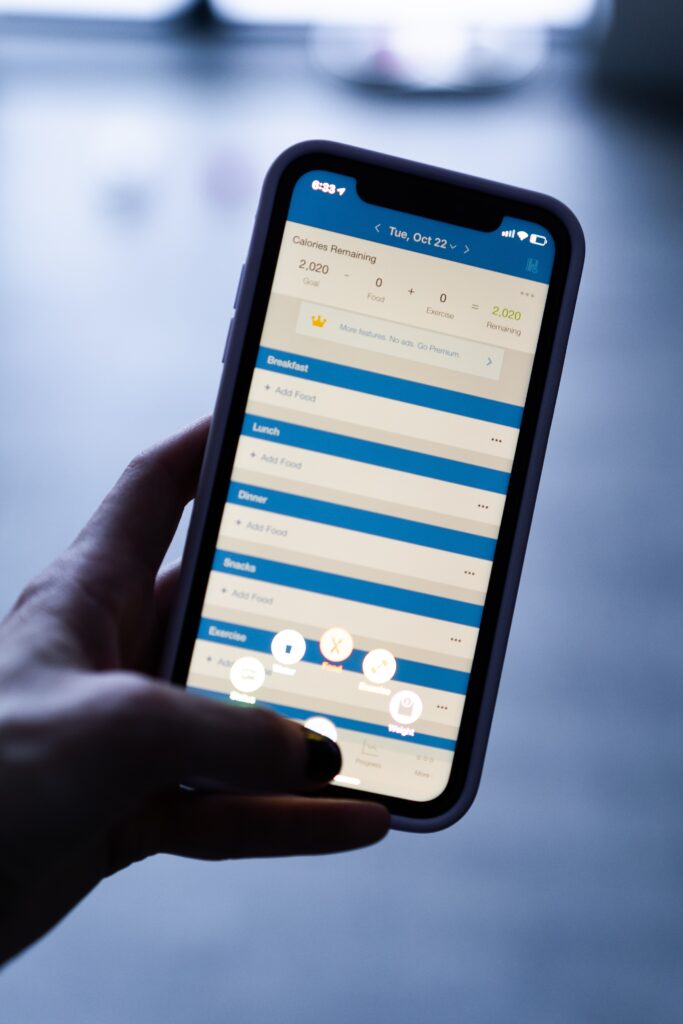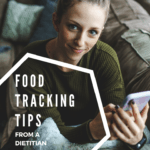I Tried Food Tracking for 30 Days – Here’s What I Learned
Have you ever tried food tracking using an app or journal? If so, you probably know that it can be eye-opening and sometimes stressful. I’m sharing my personal experience with tracking with you to shed some light on the benefits and pitfalls of this tool. I’ll also cover who should consider food tracking and who isn’t. You’ll also get some pro tips on how to be a more effective food tracker.
Why I Tried Food Tracking
If you’re reading this, you’re probably surprised for one of two reasons:
A. You’re surprised that a dietitian doesn’t track everything she eats all the time
B. You’re surprised that a dietitian would try food tracking at all.
If you’re on team A, I have to break it to you, I don’t usually track what I eat. I tend to listen to my body’s cues and respond to what it needs. (More on that later…) I try to eat a wide variety of foods and balanced meals. I don’t restrict my foods. Nothing is off limits. This usually makes me feel satisfied and pretty healthy (inside and out).
I tried tracking because I wanted to get a more objective view of my intake. I’ve definitely done this in the past, but I started feeling a little cruddy in the gym, so I wondered if I was undereating or missing out on some key nutrients. I also recommend tracking (even if it’s only for a few days) to some of my clients with specific health goals. It’s important to be willing to do anything I would ask my clients to do.
My Tracking Experience
A Little Background on Me:
When I’m not dietitian-ing, I love to exercise. I walk a lot, but I also do CrossFit and weightlifting about four days per week. (Yep, I sipped the CrossFit kool-aid about 5 years ago and I’m pretty happy about it!) One of my goals is to get stronger in the gym, which will involve gaining some muscle. To support my goal, it’s important that I’m eating enough in terms of calories and nutrients.
My Self-Assessment:
I tracked my intake without changing anything for about 1 week. If you know me at all, you know that I’m not a fan of restricting any nutrients. That’s why the tracking process surprised me – when I looked at the numbers, I saw that I was essentially eating a low-carb (<40% of my calories were from carbs), moderately high-fat diet (>30% of my calories were from fat). I truly thought I ate plenty of carbs. The funny part was, even though I was under on carbs each day, I went over on my fiber goal every day.
Huh? How is that possible?
It’s no wonder I’ve been feeling a bit sluggish and stagnant at the gym lately. High-fiber carbs (veggies, whole fruit, seeds, etc.) are great, but they don’t provide as much usable energy to the body as simpler carbs do (starchy veggies, more refined grains, etc.). High-intensity exercise and strength building (the majority of the workouts I do) are fueled by stored carbohydrates. I’ve also been under-fueling in terms of overall calories, by a lot, which doesn’t help.
In terms of other nutrients, there weren’t too many other surprises. I was able to meet most of my micronutrient goals like iron, calcium, and potassium, especially when I ate a hearty breakfast.
Positives:
- It made me realize I was under-fueling and empowered me to eat more.
- I was able to turn it into a fun game. (I like nutrition, okay?)
- The process gave me data to see my intake in a more objective way.
Negatives:
- It made me obsess a bit towards the end. (I felt some stress if I didn’t meet a nutrient goal.) I can see how food tracking could be triggering for someone with a history of disordered eating.
- It felt arbitrary at times. At the end of the day, it’s all just an estimate. (Like, does it really matter if I eat one more gram of rice today?)


When You Should NOT Track Your Food
If you have a history of disordered eating, I would NOT recommend tracking your foods. The process of measuring and logging in every bite you eat can make you feel preoccupied with foods and may trigger you to restrict yourself. (Not sure if this would apply to you? Try this quick screening test.)
If you’re not into numbers, data, or technology, you might find food tracking tedious, which can make it stressful and counterproductive.
If you think food tracking would cause more stress than it’s worth, don’t feel like you have to do it! There are plenty of ways to pursue wellness.
When You Should Track Your Food
If you have a goal that you’re trying to meet through nutrition, tracking is worth a try.
What goals am I talking about? Fat loss, muscle gain, sports performance, or managing some nutrition-related conditions. For example, people with diabetes may try tracking to manage their carb intake; people with an iron deficiency may want to check if they’re getting enough iron; people with high blood pressure may want to check on their sodium, potassium, calcium, and magnesium intake. In all of these situations, knowing where you stand with your nutrient intake can help you focus on making the appropriate modifications to meet your goals.
If you’re just plain curious about your nutrient intake, tracking can be a fun experiment. (Yep, I said fun.) Especially if you like data and technology.
Intuitive Eating Versus Tracking
This is most likely going to be an unpopular opinion with any of my dietitian friends reading this, but I’m saying it. In my experience, both intuitive eating AND tracking are tools, not dogma. It is possible to use both, even at the same time.
For those of you reading who may not be familiar, Intuitive Eating is based on 10 principles that help you tune into and trust your body’s natural cues related to food. No judgment. No food rules. No dieting. (I’m a big fan.)
In the food and nutrition space, many practitioners (including the authors of Intuitive Eating) would say that anything that involves tracking does not count as intuitive eating. I agree with that sentiment. Intuitive eating involves listening to your internal voice when making food choices, not external cues for when/what to eat. Food tracking with an app or using certain rules would count as an external cue, therefore not intuitive eating.
While I agree that food tracking is not an intuitive eating skill, I don’t feel that you need to choose one side or the other forever. It doesn’t have to be a black-and-white thing.
In some situations, tracking is not helpful, but in some situations, it can be a helpful awareness-building tool. A person who tracks their foods can still incorporate intuitive eating principles, like listening to their body’s hunger and fullness cues to decide when to stop eating or eat a bit more. A person who regularly practices intuitive eating can still track their foods occasionally if they’re curious about their nutrient intake. No shame in either.


Tips for Successful Tracking
- Get a baseline. To start, track your foods for 3-7 days without changing anything. When we know that our food is going on record, we want to appear “nicer” on paper. This is an awareness building exercise at first. You won’t learn about the real patterns going on in your life if you aren’t aware of them. After this period of time is over, do a little assessment and make goals from there.
- Decide on your method – app, paper, journal? You can build awareness with paper, but you’ll get more info from an app. Tracking on paper can allow you to keep a record of the foods, food groups, and portion sizes you ate. You can even track meal times and how you’re feeling. This method won’t give you detailed nutrient information – you’ll have to dig for this information or estimate, neither of which is very helpful. Apps give you more data to play with and do a lot of the heavy lifting for you. Some tracking apps include MyFitnessPal, LifeSum, LoseIt, and Cronometer.
- Log as you go. If you’re using a mobile app, track as you eat. Your phone is never too far away from you anyways.
- Pre-log. Too busy to remember tracking during the day? Try plugging in your planned meals and snacks the night before. You can absolutely change your plan as you go depending on how the day goes, but the extra attention you pay to plan your day can make a big difference and re-assure you that you’ll meet your goals.
- Make recipes. One of the top complaints I get about food tracking is that it’s hard to track homemade foods that you eat often. (Not if you make recipes, y’all.) If you’re using MyFitnessPal, enter your recipes for the week into your tracker and you’ll only be one click away from logging your meal.
- Be curious, not judgemental. You’re not a bad person if you ate too many calories. You’re not a failure if you went over your sugar goal for the day. (Unless you stole candy from a baby, ate it, then logged it. Shame on you.) Instead of thinking, “crap” when you see something that looks off, practice saying, “huh. That’s interesting.” Shaming yourself about foods is not the point here. The point is to build awareness of patterns. Be a detective and use the data for good tomorrow!
- Don’t cram in food to meet arbitrary goals. If you’re hungry, eat. If you’re not, don’t force yourself. At the end of the day, you know yourself better than an app does.
- Most importantly – Don’t feel like you have to track your foods forever. I only recommend tracking as a short-term experiment. Unless you end up really loving food tracking, I’d recommend it in short spurts of 3-30 days. Use tracking to get an objective view of your strengths and areas for improvement, experiment with new strategies, then use what you learned to get out there and EAT!
Have you tracked your foods before? If so, was your experience different from mine?
I’d love to hear your perspective in the comments!
